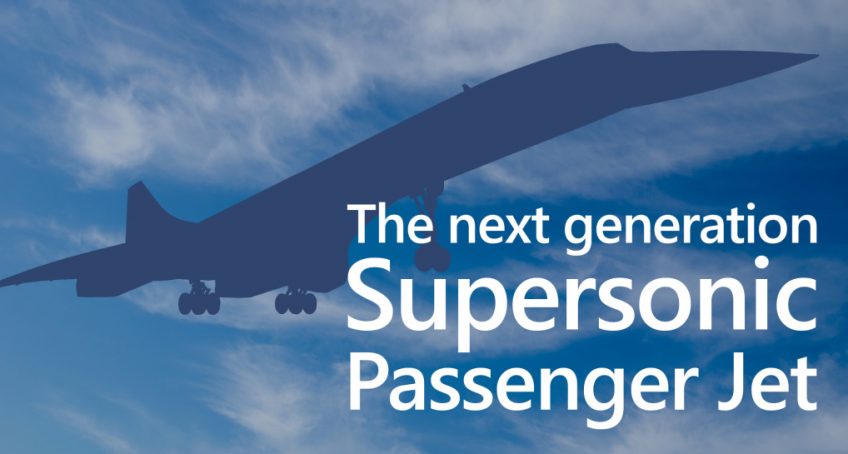October 24th, 2003 marked the final commercial flight of Concorde. Since then no commercial aircraft has been capable of supersonic flight. With rising fuel costs, increasingly efficient subsonic flight and a ban of supersonic flight over land, it seems as though the era of supersonic civilian flight is over. However, a new wave of interest is being driven by promising advances in aircraft technologies and new designs. Companies such as Aerion, Boom, Spike and HyperMach are investing in supersonic flight technologies, and if things go as planned, commercial supersonic flight could again be a reality in a few years.
Aerion AS2

Working with Airbus and conducting flight tests with NASA over the last ten years, Aerion is nearing production of their AS2 Jet. The company already has $2.4 billion in orders for 20 of their supersonic AS2 jets. The AS2 will rely on a supersonic laminar flow wing and fuselage design to enable supersonic flight with less drag and reduced sonic boom. They have been developing their technology since 2002, using advanced computational models to perfect the aircraft design. With support from NASA, Aerion performed flight tests of a laminar flow wing on an F-15B test platform to further refine their design and models.
Aerion hopes to tap into a market of time-strapped individuals willing to pay a premium to minimize their travel time. They aren’t the only ones who believe in the economics of the platform. FlexJet, a fractional jet ownership company, has already placed orders for the AS2.
With orders coming in from FlexJet, the AS2 shows more promise than many other supersonic hopefuls. Aerion and Airbus have already completed many of the design aspects of the jet, and continue to push to meet their schedule targets. The next major milestone for Aerion is selecting the engines, which they hope to accomplish soon.
Boom Technology

Partnering with Richard Branson of Virgin fame, Boom promises $5,000 3.5 hour transatlantic flights – a lower price point than Concorde offered. Boom has made headlines recently by unveiling their first prototype. If Boom stays on track to fly their prototype in late 2017 they will be the first company to reach this milestone since Concorde. Much like their competitors, Boom promises an aerodynamically advanced design which has quieter sonic booms. With their prototype nearly ready to fly the viability of this technology could be proven very soon.
Boom Technology is relying on a jet design that takes advantage of the improvements in manufacturing, aerodynamics and engines. There is no single magic bullet to their design. With 44 seats in a premium seating configuration, Boom hopes to hit an economic sweet spot: the right number of passengers and the right price per ticket. While most of their competitors seeking to develop supersonic flight are designing small business-jet style aircraft, Boom targets a wider commercial market and expects to fly regular routes between major hubs.
Spike Aerospace

Spike Aerospace is hard at work developing an aerodynamically advanced airframe. The company uses high-performance computing and simulation platforms to develop their cutting edge aerodynamic design. Spike hopes to develop a Mach 1.4 to 1.6 business jet capable of carrying 20 passengers.
Spike uses high-performance computing and advanced modelling software to optimize their aircraft design. By reducing simulation time they are able to turn around design optimisations quickly. They are using more than just clever aerodynamics however. Spike made the bold decision to do away with aircraft windows and instead, use external cameras and thin flat panel displays on the interior to simulate a panoramic window. This design choice simplifies the fuselage design and makes it stronger.
Spike plans to fly their S-512 jet as early as 2020. This places them in direct competition with the Aerion AS2 for both capabilities and timing. Spike is currently in the process of selecting engineers and transitioning from conceptual design to detailed design and manufacturing.
HyperMach SonicStar

HyperMach is setting high goals for their SonicStar aircraft. Their design will rely on a number of unproven technologies, a never before seen engine type called the Supersonic-Magnetic Advanced Generation Jet Electric Turbine (S-MAGJET), and plasma actuated control surfaces.
In traditional turbofan engines, the exhaust turbine is directly linked to the turbofan or compressors, a setup where neither fan can operate at its optimum rotational rate. In an S-MAGJET, each of the rotating components is decoupled mechanically, and the power transferred electrically using superconducting motors and generators, allowing them to rotate at their most efficient speeds. How HyperMach intends to create their superconducting generator and motor system remains to be seen.
The plasma actuated control surfaces will use high voltage alternating current near the surface of the aircraft to create plasmas in the air. These plasmas disturb the airflow enough to allow control of the aircraft. While conventional aircraft use mechanical systems like flaps and slats, plasma actuators allow airflow to be modified purely electrically, which has promising benefits at high speed. This technology is more science fact than science fiction and has already been investigated by NASA and other research agencies.
Conclusion
The promise of high efficiency and low boom supersonic flight exists only in simulations and computer models for now. This could soon change if these companies get the funding they need to test and develop the new aircrafts.

